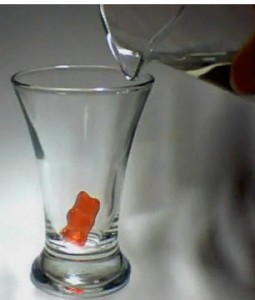Purpose: To identify the variables that might affect a red candy Gummi Bear.
Question: What effect does water have on the size of red candy Gummi Bears?
Hypothesis: This is an educated prediction. The objective is to encourage kids to analyze the question and no matter the age or science background, good reasonable “guesses” can be made. But, it is my experience that kids want clues from you. So, give them some. Introduce a few ideas to get things started, such as:
I wonder…Do you think the candy will dissolve in the water like sugar does in lemonade?
(Note: The word dissolve is introduced and instead of defining an experience is given for them to relate to.)
Explore all possible ideas. Instead of writing out hypothesis, make a list of the descriptive terms, which might include: dissolve, expand, shrink, disappear, turn green, explode (they wish), etc….
Experiment: An experiment is to determine the validity of your hypotheses.
I refrain from saying a hypothesis is right or wrong. This is because there are so many variables, which are things that could affect the results. I want kids to understand that some experimental results would be different on a very hot dry day (low humidity) from results on a rainy day (high humidity). Thus, the experiment should be done with specific variables identified and all variables kept constant except two. These will be identified below.
Materials:
2 identical glass quart jars with lids (smaller jars will work)
measuring cup
2 identical red Gummi Bear candies
What to Do:
1. Pour 1/2 cup of cold tap water into one of the jars. Add one red Gummi Bear, then seal the jar with its lid. Do not shake.
2. Place the second red Gummi Bear in the empty second jar. Seal the jar with its lid. Do not shake.
3. Set the two jars side-by-side indoor on a flat surface. The jars should be in a location with normal indoor lighting-out of direct sunlight- and where they will not be disturbed but in view for observing.
4. Observe the candy bears as often as you like, but record your observations every hour for at least 6 hours. Make note of any changes in the size of the candy bears (for use with other investigations, record other observable changes, such as any color or shape changes in the candy bear as well as any changes in the water. Record your observations in a data chart similar to the one shown.
The data chart is one suggestion for recording experimental results. Andrea Roseman, from What Ever Phillipians 4:8, used other methods for recording data, one being to take photos, such as the glass with the gummi bear. Note that instructions of using a jar with a lid were not given to Andrea. But, as the note below the picture states, an index card could be placed over glasses if you do not have jars with lids.

Andrea also used a written record, described by her:
“We decided to make a four-square chart where drawings of the bears were made every hour, or when we observed them. The original gummi bears were traced on the paper.”
Andrea noted that other recorded data included, where the jars were placed (outside in the sun, outside in the shade, inside on the table, and inside on the windowsill).
We decided to do two different colors of gummy bears. We chose green and orange.
Tracing the original gummies….
I asked each of them to make a guess about what would happen to the gummy bears and if they thought that the different colors would make a difference.
Grant:
I don’t think the color will make a difference.
He did think putting them in different places would make a difference.
He thinks putting them in the sun will make the biggest difference in what happens.
I think they will all look like little specks, but the ones in the sun will be even smaller specks.
Merideth:
She did not think that the different colors would make a difference.
She did think that putting them in different places would make a difference.
She didn’t know how they would be different, just that they would be.
Placing the jars in the shade….
1. At the end of the 1st hour, here were the results:
Outside in the sun: These shrunk and the green one was smaller than the orange one. They also colored the water.
Outside in the shade: These got bigger and they appeared to be the same size.
Inside on the windowsill: These got bigger and the orange one was bigger.
Inside on the table: These didn’t change much at all other than some of their color being faded. Both colors seemed to be the same size.
2. At the end of the 2nd hour, here were the results:
Outside in the sun: These were completely gone. The orange one tinted the water orange, and
the green one barely had any color in the water.
Outside in the shade: the orange gummy bear was biggest, but both of them got bigger.
Inside in the windowsill: the green one was biggest, but both got bigger.
Inside on the table: the green one was biggest, but both grew a little bit
3. After the 3rd hour:
Outside in sun: There was no color in the green jar at all; the water in the orange jar was still orange.
Outside in the shade: the green gummy was bigger, but both grew bigger.
Inside in the windowsill: They got bigger and the orange one was biggest.
Inside on the table: They were both bigger and they lost some color. The orange one was biggest.
4. We did this an additional time and the kids drew pictures of them, but I did not document their answers. It was supper time )
We learned that the color did make a difference in what happened to the gummy bears. The size
varied each time, going back and forth from green and orange being the one that was the biggest. In the end the Orange one was the biggest for all of our jars.
We were surprised that the water in the green jar was clear, in the one that we placed in the sun.
The gummy bears that expanded the most were the ones that we placed outside in the shade.
All of the gummy bears did expand, and stay in one piece except for the ones that melted completely.
Grant had guessed that they would turn into specks, so he was surprised that they stayed in one piece.
We had a lot of fun observing the changes that took place each hour in the gummy bears. Here are some pictures of what they all looked like in the end.
